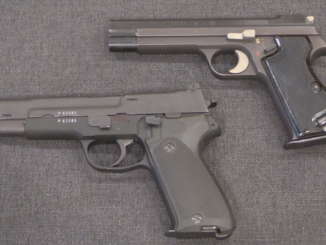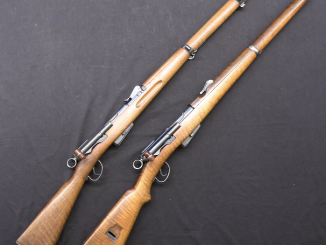The model 1895 Müller automatic pistol is an interesting and unusual design, despite being a simple blowback action. Where most pistols have a bolt or slide that moved directly rearward, the Müller pushes the bolt in a semicircular arc into its grip. This is similar to the Swedish Hamilton trials pistol that would come a few years later, and somewhat akin to the much more recent Kriss Vector design.
I was unable to find any reference to the Müller in any trials documents, so I don’t know if it was a competitor in any of the European military handgun competitions. For that matter, I’m not sure exactly what cartridge it used, beyond the 7.5mm bore diameter.




New materials and refinements but nothing really new in firearms development.
I would say 99% of now used solution in fire-arms were patented before end of WWII.
“Müller pushes the bolt in a semicircular arc into its grip”
Now I think it might address some clients concerns: fear of getting slide launched into face. Nowadays it might look strange but in 1890s were used to revolvers where is no slide at all. And in fact some early automatic pistol might launch slide – namely Warner Arms Infallible .32 automatic pistol when wrongly assembled.
To get recoil mitigation like the KRISS probably requires the use of a shoulder stock. Shooting this gun without one probably drives the grip deeper into the hand and increasing muzzle flip.
Its a pistol in an not that powerful cartridge, not an smg in .45.
It made me think about a rolling block concept modified and adapted to blowback mecanism.
I assume machining pieces would have been expensive, but in the other hand, this apparent simplicity seems to be a good point for a field item.
What about testing this kind of design today?
Would it be safe enough?
I believe the Hamilton pistol was based on Müller’s patent, which would explain the resemblance.
According to Ezell’s Handguns of the World (p. 322), Müller submitted a later self-loading pistol prototype in 7.65 x 21mm Parabellum to the U.S. Army for trial in 1905. From the photo, it is difficult to determine exactly how the breech locked, although it might be a variant of the Browning lock used on the M1897 Winchester shotgun.
The Army rejected it due to a weak firing pin and uncertain ejection, according to Ezell.
cheers
eon
“I believe the Hamilton pistol was based on Müller’s patent, which would explain the resemblance.”
Where do you see this? From the patent illustrations, the Hamilton pistol is a very different mechanism.
Can anyone point me at a link to either the Müller or the Hamilton patent?
Might they have been registered in the U.S. under an agent’s name?
All I can find are a few scans of the Hamilton illustrations from what I assume is the British patent.
Here’s the British patent for the Hamilton pistol:
https://worldwide.espacenet.com/publicationDetails/biblio?FT=D&date=19010511&DB=EPODOC&locale=en_EP&CC=GB&NR=190100286A&KC=A&ND=5
Still looking for the Müller one.
Though the cartridge it uses being unknown, the breechbolt seems rather little to stand against blowback force through its mass. Might it be possible for the hammer to give a locking effect similar to the rolling block mechanism… Very small rebounding motion of hammer might create a momentarily locking at rear of breechbolt and this pistol might have it.
I wonder how if it would help with felt recoil and muzzle flip. I suppose the recoil force would be directed down toward the grip frame and be directed more to the lower part of the hand/wrist area.
It is Aris Chronis “curved” pistol – friend of Müller and Hamilton 🙂
https://worldwide.espacenet.com/publicationDetails/biblio?DB=EPODOC&II=0&ND=3&adjacent=true&locale=en_EP&FT=D&date=19091011&CC=AT&NR=39155B&KC=B